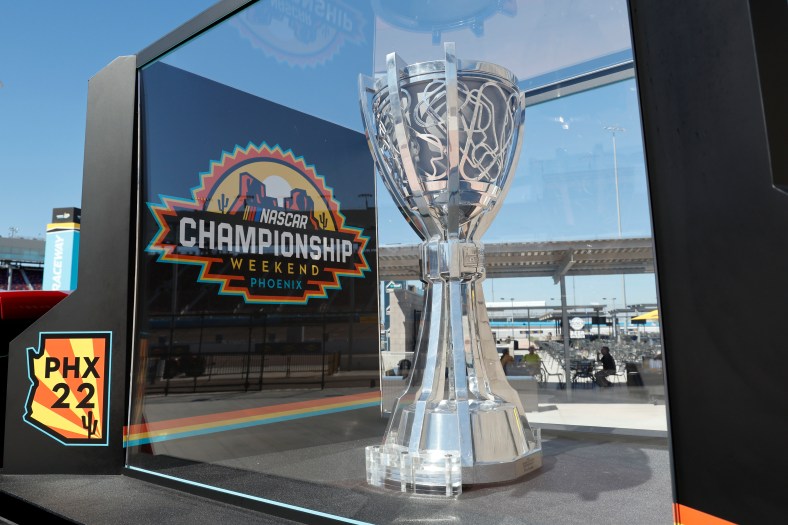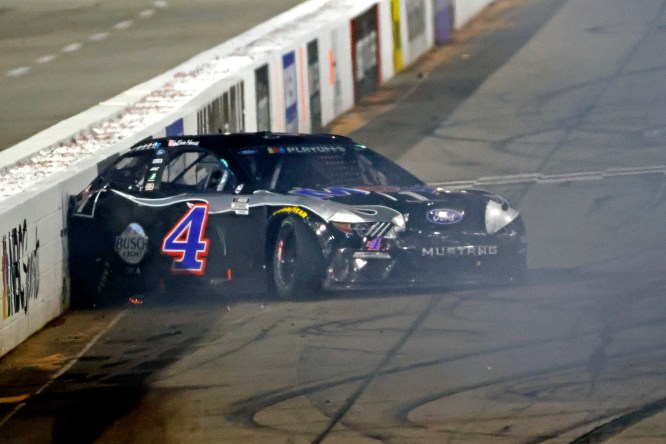
“Well, you don’t win them like Earnhardt did.”
No one has experienced the highest highs and lowest lows of the modern NASCAR championship quite like Kevin Harvick, who emerged victorious in the inaugural elimination format in 2014 but came up short in 2015 and 2020 despite having objectively superior seasons.
This autumn marks a decade since the sanctioning body injected the chase for the championship with equal parts chaos and intensity.
For the better part of 30 years, NASCAR used the Latford System to straight-up crown a champion on points earned throughout the entire season. Then came the first iteration of the stock car playoff, a 10-race points battle between the top-10 drivers after the 26th race of the season, a format Jimmie Johnson effectively dominated.
Thus, NASCAR devised a system that, at face value, was too random to be dominated over consecutive seasons. The final 10 races were split into three three-race rounds that eliminated four drivers at a time. The final race provides the final four remaining contenders an equal chance to win it all.
There hasn’t been a repeat champion since.
“We’re definitely in the entertainment business, to make things exciting,” Harvick said. “As you look at the last race, and there’s a lot that goes into getting to that point, but it definitely doesn’t reflect the whole season and I think our years are probably proof of that. We won the right race in ’14 and didn’t win the right race in ’15.
“In ’20, we didn’t win the right race.”

That 2020 season remains Exhibit A for how the entertainment value of the format can supersede sporting integrity. That season, Harvick won nine times but failed to reach the final four due to a series of catastrophic events.
At the same time, NASCAR would point towards the 2007 undefeated New England Patriots that ultimately lost in the Super Bowl to the New York Giants. Playoffs are inherently about meeting the pressure of the moment and executing when it matters the most.
Kyle Larson did in 2021 what Harvick was unable to do the year before, reaching the championship race with nine wins, and scoring another one to complete a near perfect campaign. A testament to his formative USAC days, Larson prefers the purity of a season-long points chase but has also come to enjoy the pressure cooker of the final 10 races.
“I like the playoffs a lot,” Larson said. “It’s pressure packed, for sure and I feel like our team has always been up to the challenge.”
Like Harvick, Daytona 500 winner Ricky Stenhouse Jr. also has two Xfinity Series championship under the classic points format. He feels very proud of those accomplishments but he’s also a PGA fan and likens NASCAR to how golf crowns its champions these days, too.
“I think every sport has done something to make it more exciting, make their playoffs a little more intense over the years,” Stenhouse said. “I enjoyed the Nationwide Series Championships. I loved that it was a season-long deal.
“But I’m looking forward to the playoffs and the opportunity to race for a championship this way this season too.”
Brad Keselowski won the Xfinity Series championship under the classic format in 2010 and won the Cup Series championship two years later under the original playoff format before the elimination format. He says the latter, and its emphasis on winning over the course of the regular season and playoffs, has forever changed the ways drivers treat each other.
“Certainly, the dynamics are different, the behavior is different because what it makes us value is different,” Keselowski said. “I would argue in some cases that it makes for better racing and other ways it doesn’t but I don’t think you can argue that the values and behavior is different.”
To wit, that first autumn under the elimination format led to several fight, including two involving Keselowski with both Matt Kenseth and Jeff Gordon, respectively. A year later, a series of on-track incidents led to Kenseth intentionally crashing Joey Logano at Martinsville for denying him a championship race berth.
It was all a byproduct of how the format of the intensity suspends traditional racing ethics when nothing less than winning matters.
In 2016, Logano triggered a crash with a front-running Carl Edwards in the closing laps of the championship race at Homestead, costing both a chance at the title. A dejected Edwards would mysteriously retire five weeks later and hasn’t raced sense.
Those close to him say the way he lost that championship factored into that decision.
Ross Chastain, needing two spots in one lap at Martinsville in November, drove full throttle into the wall around the final two corners in what was best articulated as a video game move to earn the spot he needed to advance to the final four.
There is no other scenario in motorsports where running a handful of spots outside the top-five would encourage a driver to make such a bold, reckless and desperate decision. It has since become the poster-image for the modern playoff format.
For both that reason, and how it gives 16 teams varying opportunities to win the championship with 10 weeks remaining, is something that Chastain appreciates.
“Look at our season, where we have fallen from being the points leader to being 100 points out and I don’t think we would have had a realistic shot to win the championship if this was a season long format,” Chastain said. “I love it because it gives us a real shot.
“It (gave) Chase (Elliott) and Alex (Bowman) a realistic shot. It gives a shot for teams who are hundreds of points back or those who missed races. I’ve had the points lead, coughed it up and fell 100 points back. We wouldn’t have a chance without it.”
The same is true for every fanbase too.
In a bygone era, Elliott and Bowman missing races would have meant the immediate end of their championship hopes. Their significant fanbases still had hope that a championship was possible up until the regular season finale and a race at Daytona where literally anyone could have won their way into the Field of 16.
Kyle Busch missed the first 11 races of the 2015 season with a leg injury sustained at Daytona but came back to win five races and his first championship.
Denny Hamlin has reached the championship race four times in nine seasons but is still looking for that elusive first championship. He has lamented at times how much the current format has eroded the purity of previous era, but he also recognizes all the ways fans have been entertained over the past decade.
“It’s the fine line we run between entertainment and pure racing, right,” Hamlin said. “It needs to be an entertainment sport because that’s what we’re doing, entertaining an audience.
“The format in which we crown a champion has changed over the years under the influence of trying to create these exciting moments. We’ve had them and sometimes they happen naturally but certainly this format creates very important cutoff races and has a very important final race that crowns a champion with four guys that are all technically level when they get there.
“It is what it is. We play by the rules and do what we can.”
William Byron, who enters the 2023 playoffs as the top-seeded driver doesn’t even know what it’s like to race without a playoff format. He was six years old when NASCAR first introduced the original Chase for the Championship in 2004 and was a teenager when it swapped over to the elimination format.
He has raced in the format across Craftsman Trucks, Xfinity and now the Cup Series.
“I think it’s what sports and the playoffs all are about,” Byron said. “It tests us physically and mentally. I think it challenges us to be prepared. It means something when you excel at it. I think it checks all the boxes for what a playoff in sports should be.
“It’s stressful throughout those final weeks, but I wouldn’t want it any other way.”
Back to Harvick, who will have one more chance to win another championship over the next 10 weeks before joining the FOX Sports television booth, admits he will enjoy covering the format even if he didn’t entirely appreciate it from behind the steering wheel.
“I can see it both ways,” he says. “I’m going to sit on the other side of the fence and want it to be exciting but I have also raced (for a championship) both ways and I just think it’s a long season and there is a lot for it to just come down to one race.”
That’s the entertainment business for you.
Matt Weaver is a Motorsports Insider for Sportsnaut. Follow him on Twitter.